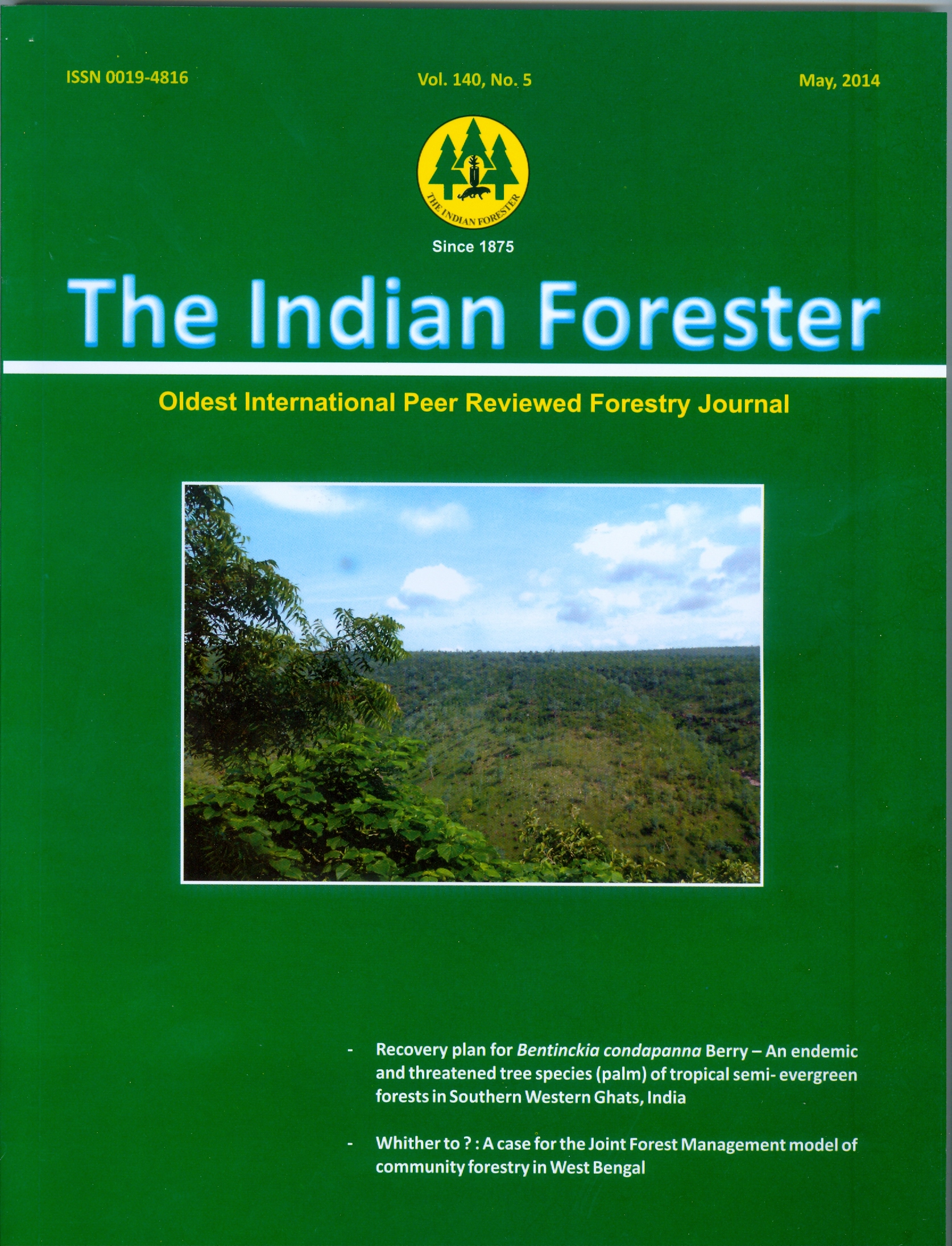Biodrainage for Restoration of Canal Command Waterlogged Area in Indian Desert
DOI:
https://doi.org/10.36808/if/2014/v140i5/49090Keywords:
Biodrainage, Biomass, Eucalyptus Rudis, Transpiration, WaterloggingAbstract
An attempt was made to remove excess water from the land through bio-drainage and to increase vegetation cover and productivity of a waterlogged area in Indian desert. Area protection, soil working and plantation of Eucalyptus camaldulensis, E. fastigata, E. rudis and Corymbia tessellaris on raised bunds, improved vegetation cover with simultaneous decrease in water table. Performance of E. rudis was best with respect to growth, biomass, transpiration rate and overall bio-drainage potential. E. rudis maintained uniform transpiration and photosynthesis rate throughout the year. Ground water level receded by 145 cm in E. rudis plot compared to 90 cm, 70 cm and 60 cm in C. tessellaris, E. camaldulensis and E. fastigata respectively within a period of four and half year. Soil organic carbon, electrical conductivity, NH and NO - N were high in E. rudis and low in E. fastigata. The results suggests that E. rudis has high 4 3 potential to be used as an efficient bio-drainage species in canal command waterlogged area of Indian desert. Apart from the planted species, Prosopis juliflora, Tamarix dioca and Saccharum munja also have come up in the area with recession of ground water table as natural succession and contributed significantly for further lowering of ground water table and increasing productivity.References
Angrish, R., Toky, O.P. and Datta, K.S. (2006). Biological water management: biodrainage. Current Science, 90: 897.
Archibald, D.R., Harper, R.J., Fox, J.E.D. and Silberstein, R.P. (2006). Tree Performance and Root-Zone Salt Accumulation in Three Dryland
Australian Plantations. Agroforestry Systems, 66: 191-204.
Cunningham, G.M., Mulham, W.E., Milthorpe, P.E. and Leigh, J.H. (1981). Plants ofWestern New South Wales, Soil Conservation Service of New South Wales.
Dass, B. and Ahuja, G. (1998). Impact of afforestation on salinity and ground water regime in water logged, saline and alkali areas. Indian Forester, 124: 271-279.
Gautam, M.K.., Tripathi, A.K. and Manhas, R.K. (2007). Indicator species for the natural regeneration of Shorea robusta Gaertn. F. (sal), Current Science, 93: 1359-1361.
George, R.J. (1990). Reclaiming sand plain seeps by intercepting perched groundwater with eucalypts. Land degradation and Rehabilitation,2: 13-25.
Govt. of India (1991). District census handbook, Jaisalmer, Census of India, Series 21.
Hussain, A. and Gul, P. (1991). Selection of suitable tree species for saline and water logged areas. Pakistan Forestry, 41: 34-43.
Jackson, M.L. (1973). Soil Chemical Analysis. New Delhi: Prentice Hall of India Private Ltd.
Kapoor, A.S. and Denecke, H.W. (2001). Bio drainage and Bio disposal: The Rajasthan Experience. Grid (IPTRID Network Magazine), 17: 3-4.
Karajeh, F.F., Tanji, K.K. and King, I.P. (1994). Agroforestry drainage management model I, II and III. Journal Irrigation and Drainage Engineering, 120: 382-396.
Marcar, N.E. (1993). Water logging modifies growth, water use and ion concentrations in seddlings of salt treated E. camaldulensis, E.tereticornis, E. robustaand E. globulus. Australian Journal of Plant Physiology, 20: 1-13.
Moezel, P.G. Van Der., Pearce-Pinto, G.V.N. and Bill, D.T. (1991). Screening for salt and waterlogging tolerance in Eucalypts and Melaleuca species. Forest Ecology and Management,40: 27-37.
Morris, J.D. and Collopy, J.J. (1999). Water use and salt accumulation by a plantation of Eucalyptus camaldulensis and Casuarina cunninghamiana with shallow saline ground water. Agriculture WaterManagement, 39: 205-227.
Nautiyal, S., Pokhriyal, T.C. and Emmanuel, C.J.S.K. (1994). Natural regeneration of Eucalyptus camaldulensis: a new report. Indian Forester,120: 174-175.
O'Malley, C., Sheldon, F. (1990). Chowilla floodplain biological study. Adelaide: Nature Conservation Society of South Australia.
Stone, L. and Virtue, J. (2009). Environmental weed risk assessment: E. rudis. [Online] Available: http://www.futurefarmcrc.com.au/th documents/E.rudis web.doc accessed on 4 August 2009
Thakur, N.P. and Chhabra, R. (1999). Bio-drainage best way to check salinisation. Agriculture Tribune, December 20.
Toky, O.P., Angrish, R., Datta, K.S., Arora, V., Rani, C., Vasudevan, P. and Harris, P.J.C. (2011). Biodrainage for preventing water logging and concomitant wood yields in arid agro-ecosystems in North-Western India. Scientific and Indurtrial Research, 70: 639-644.
Windmill Outback Nursery (2008). Eucalyptus rudis. [Online] Available: http://www.australiaplants.com/Eucalyptus rudis.htm
Downloads
Downloads
Published
How to Cite
Issue
Section
License
Unless otherwise stated, copyright or similar rights in all materials presented on the site, including graphical images, are owned by Indian Forester.





